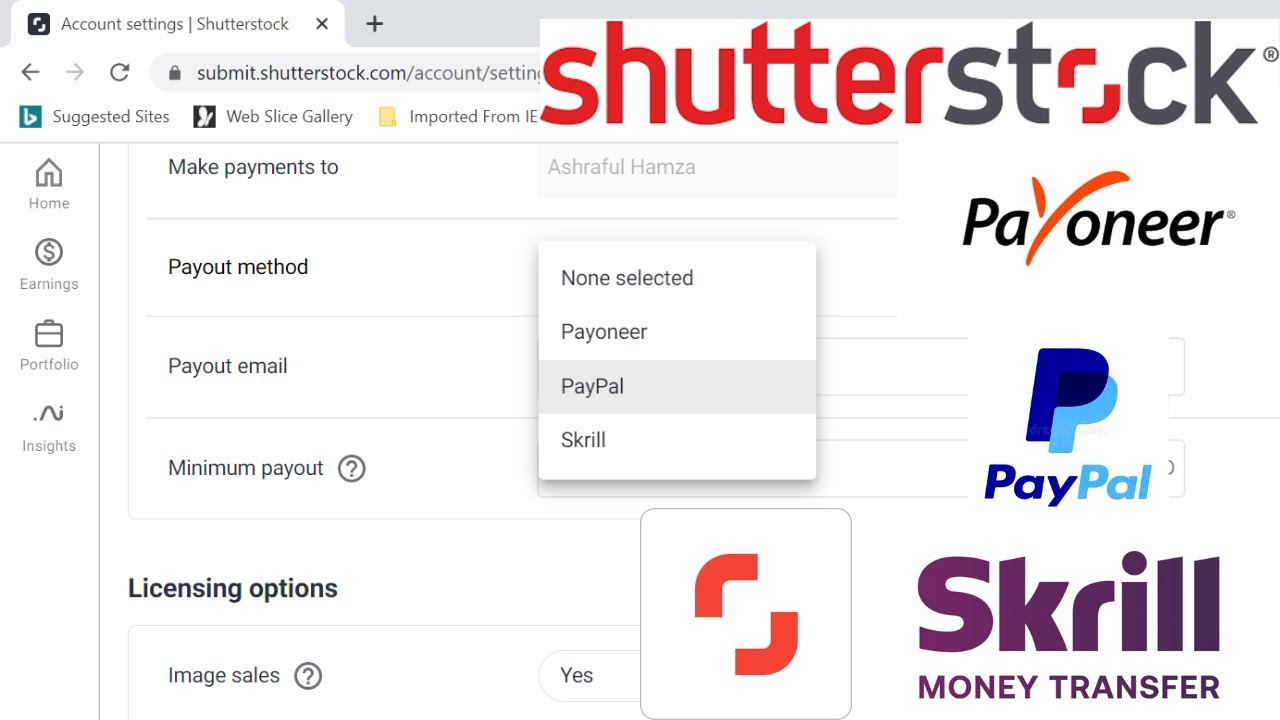Getting your photos licensed on Shutterstock is a fantastic way to turn your passion for photography into a steady income stream. Whether you’re a seasoned pro or just starting out, understanding how the licensing process works can seem overwhelming at first. But don’t worry! It’s all about sharing your creative work with the world and earning royalties every time someone uses your images. In this post, I’ll walk you through the essentials—what licensing means, how to get started, and how to make sure you’re set up for success. Let’s dive in and unlock the potential of your photo portfolio!
Understanding Shutterstock Licensing Options and Requirements

When it comes to licensing your photos on Shutterstock, there are a few key concepts to grasp. Shutterstock offers two main types of licenses: Standard License and Extended License. Each serves different needs and has its own set of rules:
- Standard License: Perfect for most uses—websites, social media, presentations, and small print runs (up to 500,000 copies). It covers online usage and basic print products like flyers or posters.
- Extended License: Designed for larger-scale uses—mass printing, merchandise, or products that will be sold on a large scale. This license allows for unlimited print runs and uses beyond the Standard License’s scope.
Understanding these options is crucial because it affects how you price your photos and how clients might want to use them. Also, Shutterstock has specific requirements for photographers to be able to upload and license images. Here are a few highlights:
- Quality Standards: Your images should be high resolution, well-composed, and free of technical issues like noise or blurriness.
- Model and Property Releases: If your photo features recognizable people or private property, you’ll need proper releases to license it legally.
- Unique Content: Shutterstock prefers original work. Avoid submitting images that are heavily edited from stock photos or infringe on copyrights.
- Metadata: Accurate titles, keywords, and descriptions are vital. They help buyers find your images easily, increasing your chances of licensing your photos.
Finally, make sure you understand Shutterstock’s licensing terms and community guidelines to keep your account in good standing. By aligning your work with these requirements, you’ll be better positioned to succeed and maximize your earning potential from each license sold.
Steps to Upload and License Your Photos for Profit

Ready to turn your photography passion into a source of income on Shutterstock? It’s easier than you might think! Here’s a simple step-by-step guide to help you upload your photos and start licensing them for profit.
Step 1: Create a Contributor Account
First things first, head over to Shutterstock’s Contributor page and sign up. You’ll need to provide some basic information like your name, email, and payment details. Once your account is approved, you’re officially a contributor!
Step 2: Prepare Your Photos
Before uploading, make sure your photos are high quality and meet Shutterstock’s standards. This means:
- High resolution (at least 4MP or higher)
- Properly exposed and in focus
- Free of noise and compression artifacts
- No watermarks or branding
It’s also a good idea to edit your photos for color correction, cropping, or straightening to ensure they look their best.
Step 3: Tag and Describe Your Images
When uploading, you’ll need to add relevant titles, descriptions, and keywords. Think about what potential buyers might search for. Be specific and accurate—this helps your photos get discovered!
Step 4: Set Licensing Options & Pricing
Shutterstock offers different licensing options like royalty-free licenses, which are standard. You can choose to enable extended licenses as well. Typically, the platform takes care of pricing based on your contributor level, but you can review your options during upload.
Step 5: Submit for Review
Once everything is filled out, submit your photo for review. Shutterstock’s team will check if it adheres to their guidelines. This process usually takes a few days. If approved, your image will go live on the platform, available for licensing.
Step 6: Track Your Earnings & Sales
After your photos are online, keep an eye on your dashboard. Shutterstock provides detailed analytics so you can see which images are popular and earning. Regularly uploading new photos increases your chances of making a profit!
Tips for Creating Marketable and High-Quality Photos
To maximize your earning potential on Shutterstock, focus on creating images that buyers are actively searching for. Here are some insider tips to help you produce marketable and high-quality photos:
Understand Market Demand
- Research trending topics: Look at what’s popular, like remote work, sustainability, or health and wellness.
- Check top-selling categories: Nature, technology, business, lifestyle, and food tend to do well.
- Stay current with seasonal needs: Holidays, seasons, and events generate high demand.
Focus on Technical Quality
- Use a good camera and proper lighting to ensure crisp, clear images.
- Avoid noise, blurriness, and over-editing.
- Pay attention to composition—use the rule of thirds and leading lines to create engaging visuals.
- Ensure your images are properly exposed and color-balanced.
Create Versatile Content
Images that can be used across various industries tend to sell better. Think about:
- People in natural, candid poses
- Generic backgrounds and scenes that can be easily customized
- Images with diverse models and settings to appeal to a broad audience
Pay Attention to Composition & Style
Consistency in style can help your portfolio stand out. Whether you prefer minimalism, vibrant colors, or a specific theme, developing a signature style can attract repeat buyers.
Be Original & Creative
While trending topics are important, unique and creative images can help you stand out in a crowded marketplace. Experiment with different angles, concepts, and editing styles to add your personal touch.
Use Proper Keywords & Descriptions
Accurate and relevant keywords help your images appear in search results. Think like a buyer—what words would they use? Avoid keyword stuffing but be thorough with your descriptions.
By combining technical excellence with market awareness and creativity, you’ll increase your chances of licensing success on Shutterstock. Happy shooting—and here’s to turning your passion into profit!
Maximizing Earnings from Your Shutterstock Photos
Now that you’re getting the hang of licensing your photos on Shutterstock, it’s time to think about how to really boost your earnings. After all, the more your images sell, the more you can earn — and who doesn’t want that?
First off, diversify your portfolio. Don’t just stick to one niche or style. The more variety you offer, the broader the range of buyers you can attract. Think about including different themes, color schemes, and subjects—people, landscapes, objects, textures, and more.
Next, focus on creating high-quality, versatile images. Sharp, well-composed photos with good lighting tend to sell better. Also, consider including images that can be used across various industries—business, tech, health, lifestyle, etc. This way, your photos become more appealing to a wider audience.
Another tip is to pay attention to trending topics and seasons. For example, during holidays, images related to Christmas, New Year, or Valentine’s Day tend to perform well. Similarly, staying current with industry trends—like remote work, sustainability, or new technology—can give your portfolio a boost.
Additionally, use relevant and detailed keywords. Shutterstock relies heavily on keywords to match your images with buyer searches. Spend time researching popular search terms in your niche and include them thoughtfully in your keyword set. This increases your photos’ visibility.
Finally, upload consistently. The more images you add, the greater your chances of making sales. Regular uploads also keep your portfolio fresh, which can encourage Shutterstock’s algorithms to feature your work more prominently.
Remember, success doesn’t happen overnight. Patience, quality, diversity, and staying on top of trends are your best tools for maximizing earnings on Shutterstock. Keep refining your approach and watch your income grow!
Common Mistakes to Avoid When Licensing Photos on Shutterstock
While Shutterstock is a fantastic platform, there are some common pitfalls that can hurt your licensing success—or even get your images rejected. Let’s go over some mistakes to watch out for so you can keep your licensing game strong.
1. Ignoring Shutterstock’s Content Guidelines: Each platform has rules about what can and cannot be uploaded. Shutterstock prohibits images with illegal content, excessive nudity, or copyrighted elements you don’t own. Make sure to review their content policies carefully before uploading.
2. Poor Image Quality: Blurry, pixelated, or poorly lit photos won’t sell. Always upload high-resolution images with good exposure, sharp focus, and minimal noise. Remember, buyers want professional-looking images.
3. Lack of Proper Model or Property Releases: If your photo features recognizable people or private property, you need the appropriate releases. Failing to obtain these can prevent licensing or cause legal issues down the line.
4. Overusing Generic Keywords: Stuffing your images with irrelevant keywords can hurt their visibility. Be honest and accurate with your keywords—use descriptive, specific terms that truly match the image content.
5. Not Checking for Copyrighted Content: Avoid including copyrighted logos, trademarks, or artwork without permission. Shutterstock’s review process is strict about such content, and violations can lead to rejection or account issues.
6. Failing to Update or Improve Old Images: If some of your older images aren’t performing well, consider revisiting them. You can update keywords, improve quality, or re-upload with better metadata. Ignoring underperforming images can limit your earning potential.
7. Neglecting Metadata and Keyword Optimization: Without proper keywords and descriptions, your images won’t reach the right audience. Take the time to write clear, relevant titles, descriptions, and tags that match what buyers are searching for.
By avoiding these common mistakes, you’ll set yourself up for better licensing success and a more profitable Shutterstock portfolio. Remember, quality, compliance, and strategic optimization are your best friends in this journey!
Conclusion and Final Tips for Successful Photo Licensing on Shutterstock
Licensing your photos on Shutterstock can be a rewarding way to generate passive income and showcase your photography skills to a global audience. To maximize your success, it’s essential to understand the platform’s requirements and optimize your submissions accordingly. Remember to always submit high-quality, well-edited images that meet Shutterstock’s technical standards, such as proper exposure, sharpness, and appropriate metadata.
Here are some final tips to help you thrive as a contributor:
- Consistent Uploads: Regularly upload fresh content to keep your portfolio active and increase visibility among buyers.
- Keyword Optimization: Use relevant, specific keywords to improve discoverability of your images in search results.
- Stay Informed: Keep up with Shutterstock’s submission guidelines and trending topics to tailor your portfolio accordingly.
- Protect Your Work: Watermark your images during submission and only license high-resolution files once approved.
- Engage with the Community: Participate in forums and read other contributors’ experiences to learn best practices and improve your strategy.
By following these tips and consistently refining your approach, you can enhance your chances of earning a steady income through Shutterstock’s licensing platform. Patience and persistence are key—building a successful portfolio takes time, but the potential for profit and exposure makes it well worth the effort.


